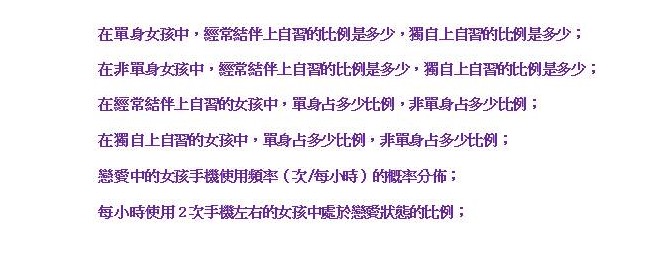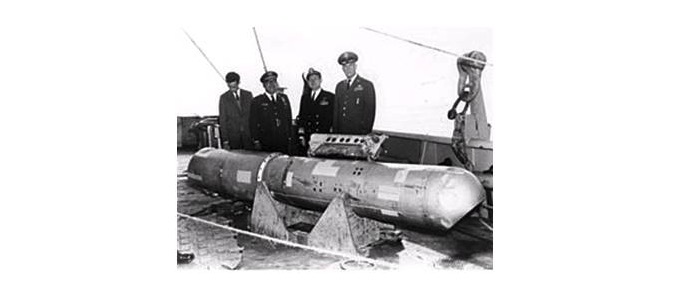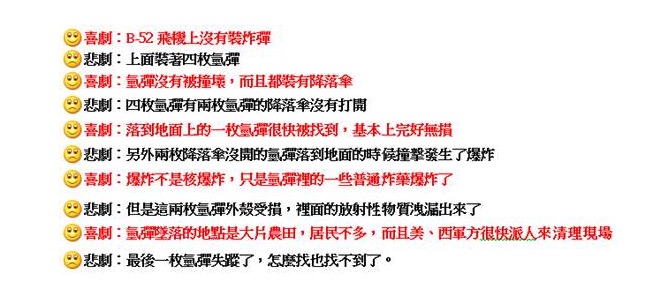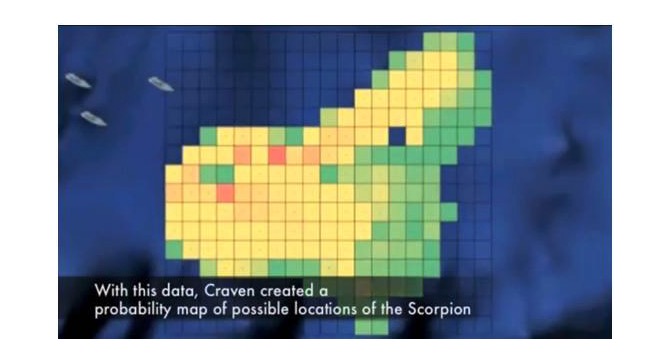Chasing the Girl and Finding the Missile, the statistical formula of Bob Bees
Author: The Little Dream, Created: 2016-12-15 12:30:32, Updated: 2016-12-15 12:32:49Chasing the Girl and Finding the Missile, the statistical formula of Bob Bees
-
ONE
In the emotional life of the moralistic people who do not understand the style, they inevitably encounter such a sad scene: they meet a beautiful girl with a heart, from this day on, they think about the night, forget about sleep, start a long journey of intimacy, wait until one day, in an endless tangle, finally muster up the courage to confess to the girl, the result is a girl saying "I already have a boyfriend, it's hard to accept"...
In order to avoid this embarrassment, how to accurately judge whether a girl is single has become a must-read.
If you work with the girl and are often with her, it is not difficult to know if she is single. But the high difficulty task for mortals is to complete: as a stranger who maintains a distance from the girl, you can judge the girl's single status with the limited information at your fingertips without her noticing.
The method is as follows: first step, to believe in intuition. The morally rational party can consider finding more friends together and secretly observe the target girl, of course the people looking for are not all morally rational, what is the mindset identification group, rumor crusher, natural control, forensic pathologists are best to find a few, married people, the scene master, pickpocketing thieves also look for, the more people, the better, the more diverse. Then everyone according to their own impression of the mm estimate from their own point of view how much the target is the probability of being single, cast a ballot, the final result will be different.
The above results are only based on the results of the voters' personal experience, which is in line with the objective rationalist style of doing things? For this, we will take the second step, to talk with facts and evidence.
Just like doing scientific research, you can first look up information, and a random search on google can find simple and easy-to-use single-judgment criteria that many lonely people have been studying for years, such as the mobile phone principle (the girls in love will use their phones more often), the self-study principle (single girls often pair up with several girls to self-study); after that, do a statistical experiment to find out whether the single girls are in the population, of course, the larger the sample, the better the results.

The statistics of this kind of thing.
When all the data from the experiment is in hand, we can continue to make corrections and optimizations to the 65.65% probability value just voted for. What is relied on? What is the natural performance of the target girl on various criteria. For example, the target girl likes to go to the gym with her friends, which according to the results of her own study of yoga statistics:
So now the target mm is going to be the probability of being single.

The heart of the rational person must be deeply rejoicing, and hope has increased!
If the results also show that 20% of single girls use their mobile phones more than 1.2 times/hour, and 60% of girls who are already in love, then the probability is updated.

The probability of being single has fallen dramatically again to 56.02%, and the moralistic can look for more critics of the nuclear standard, do more research, constantly update the girls' probability of being single values, to bring it closer and closer to the truth, but before getting the final result, you have to set a threshold: the girls' probability of being single exceeds this threshold (for example, 90%), and you are worth the watch, otherwise, you can die.
However, it should be noted that no matter how many times you count, the result is a probability value, not a fact, even after multiple studies, you can already determine the target girl's probability of singleness to 99.9%, immediately ready to confess to her, but in the last observational study of the girl, if you find that the family and a boy holding hands have something to say, laugh, hug, then the probability value of the girl's singleness will immediately fall from 99.9% to close to zero, the consequences are understandable...
This article tells you that this method of judging whether or not mm is a single scientific and rigorously rational method is called the Bayesian statistical method. The Bayesian method is simply to say that the prior probability + newly obtained evidence = corrected probability is unlimited in the amount of information that can be gathered from various sources, including subjective judgments and limited objective information.
However, the Bayesian method, invented by the Mortuary Rationalists, is not to be underestimated, as the US Navy has used it to search for lost hydrogen bombs and missing nuclear submarines in the Pacific Ocean.
-
TWO
One day in January 1966, a U.S. B-52 bomber flew over Palomarés, Spain, with several pilots on board performing an aerial refueling mission assigned to them by Air Force Command. The flight was not considered dangerous, and the captain was said to be a calm person who liked to take two puffs of a large pipe, even in the cockpit. But the captain and several of his subordinates were in great trouble and could not enjoy the puffs of a cigarette again.

But the story is not over, and a series of tragedies and comedies follow.

In order to find the missing cluster bomb, the United States hastened to mobilize a search party from within the country, including a number of experts, including a mathematician named John Craven, who was the chief scientist of the US Navy's Special Programs Division.
Craven's solution to the problem of finding the bomb used the Bayesian method just mentioned, and he called together experts in all fields, but each with their own areas of expertise, not their own talents. Some knew a lot about the B-52 bomber but little about the properties of the bomb. How the bomb was stored on the plane was a problem, how the bomb fell off the plane was a problem; whether the bomb would go with the debris of the plane was not an answer; what was the probability of the two parachutes on the bomb opening each other?
For these various questions, Craven asked experts to make assumptions, imagine various scenarios, and then speculate on the probability of the hydrogen bomb at various locations and the likelihood of each scenario.
Craven's approach has also been questioned by his peers, because many of the results in his scheme are obtained by these experts in the form of guesses, votes or even gambling, and the accuracy of all results cannot be guaranteed, but because of the urgency of the task of searching for the hydrogen bomb, there is no time to perform precise experiments, to establish a complete and reliable theory, Craven's method is not a viable method.
After getting the results from the experts, Craven put them together and drew a probability map of the location of the bullet: he divided the entire possible region into many small squares, each with different probability values, highs and lows, such as the highs and lows of mountains and valleys on a map. Like the first step in the Bayesian method of judging whether a girl is single or not, Craven completed the Bayesian method.
Afterwards, Craven and the commander of the search team began a search for the bomb, updating the probabilities of each grid at the same time, but the most probable grid indicated the location of the canyon and the deep sea on land, so it was necessary to draw another probability map, which indicated that the bomb was already there, and the probability of finding the bomb rather than the probability of the location of the bomb.
Only two years later, in 1968, Craven had a chance to play again, dropping a small lead bullet, this time to the U.S. Navy.
In June 1968, the U.S. Navy's Swan nuclear submarine suddenly disappeared in the Atlantic Ocean, leaving the 99 Navy officers aboard the submarine and the boat without radio communication. According to a post-investigation report, the culprit was a strange torpedo on board the submarine, which was fired by the enemy and then twisted and fired at itself, causing the submarine to explode.
The U.S. Navy conducted a massive search to locate the Svalbard, and Craven was involved. Due to the speed of the submarine's navigation at the time of the accident, the direction, the size of the blast, and the direction of the submarine's direction of impact at the time of the explosion were unknown, and even knowing where the submarine exploded, it was difficult to determine where the submarine wreckage was finally washed away. Craven estimated, in a preliminary estimate, that the Svalbard submarines were likely to lie there within a half-mile radius of the sea floor, and that it was almost impossible to find the submarine at such a large range.
No expert can accurately estimate what happened to the submarine before and after the incident, and as with the search for the cluster bomb, Craven consulted mathematicians, submarine experts, and experts in various fields of maritime search and rescue, writing a variety of possible satirical books to allow them to speculate from their own knowledge and experience on which direction the situation would develop. It is said that to add some fun to the boring work, Craven also prepared whiskey as a reward for betting the right beer.

Finally, Craven obtained a 20-mile-wide probability map of the ocean. The entire ocean was divided into many lattices, each with two probability values p and q, where p is the probability that the submarine lies in the grid and q is the probability that it is searched if the submarine is in the grid. According to experience, the second probability is mainly related to the depth of the ocean, and the probability of a submarine leaking the net is greater when searching the deep sea area.

The probability of the existence of submarines in the other grids will increase:

Each time a search is made, a grid with the highest probability of submarines in the area is selected for the search. If it is not found, the probability distribution map is washed once, and the search vessel heads to the new and most suspicious grid, and so on until the swan is found.
Initially, the Navy's estimate of the submarine's location on the eastern side of the explosion was rejected by Craven and other mathematicians, but after months of searching, nothing came of it. The Navy had to follow Craven's suggestion that the submarine should have been on the western side of the explosion. After several searches, the submarine was found on the southwestern side of the explosion.
After two attempts, Craven's Bayesian approach to maritime searches became widely accepted, and the Bayesian method became a catch-phrase that has since become a worldwide phenomenon. Over the decades, the Bayesian method has become more widely used, penetrating every nook and cranny from Google search filter words to autonomous vehicles to determine one's own driving position.
Translated from Mathematical Modeling at the University of Arnhem
- What are the advantages of leveraged trading?
- Here are 20 questions you didn't know about futures trading tips!
- Robots often report mistakes and disconnect
- How do traders sell off risk?
- Robots are getting information that is often wrong, is there a good solution?
- The least common multiple of the linear regression theorem
- Seven regression techniques you should master
- Gauss and the Black Swan
- The Bretton Woods system
- Which god can help me write a simple strategy?
- Is the Bitcoin spot trading platform without idle and leverage application functionality?
- I'm going to tell you a few simple, easy-to-understand stories about statistics.
- Can quantitative trading be modularised to make it easier to get in?
- The top 10 secrets that a good cook can't tell
- The price strategy of the Fiat 4
- Interesting quantitative short stories - multiple heads and blank heads
- Distribution options that simulate retesting use their own servers to prompt errors
- Changing the month of the main futures contract
- Aberration policy
- The 10 most basic utility algorithms that programmers should know and their explanations